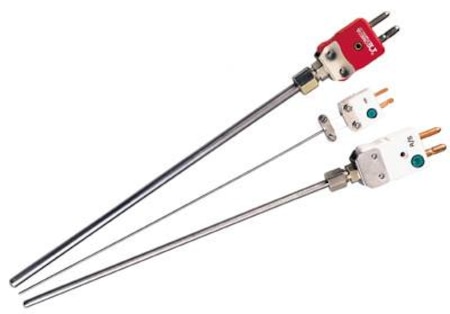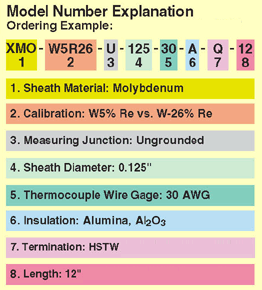1-800-663-4209 | Your feedback matters, take a quick survey Website Feedback

XTA-W5R26
Extreme Temperature Exotic Thermocouple Probes
Models In Stock
- Sheaths
• Tantalum
• Molybdenum
• Platinum/Rhodium
• Inconel 600 - Thermocouple Elements
• Tungsten/Rhenium
• Platinum/Rhodium - Insulations
• Hafnium Oxide (HfO2)
• Magnesia (MgO)
• Alumina (Al2O3) - Mating Connector Sold Separately!
XTA-W5R26
From
$
149.88
Models In Stock
Product Overview
- Alloy Material (-) Platinum - 6% Rhodium
- Alloy Material (+) Platinum - 30% Rhodium
- Color Code Standard ANSI
- Junction Type Ungrounded
- Operating Temperature, Min 0 °C
- Process Connection Size N/A
- Process Temperature, Min 0 °C
- Temperature Sensor Type Thermocouple
OMEGA Exotic Thermocouple Probes are designed for use in extreme temperatures, up to 2315°C (4200°F). These probes utilize either Platinum/Rhodium (types R, S, or B) or Tungsten/Rhenium (types G, C, or D) elements, with a variety of insulations and sheath materials. Depending upon the sheath material selected, these probes may be used in inert, oxidizing, reducing or vacuum conditions. The maximum temperature is based on the lowest max. temperature of the element, insulation and sheath material. Five cold end probe terminations are available: replacement probe, subminiature or standard size ceramic connector, heavy-duty standard size, molybdenum-sheathed nylon connector, or transition joint with 72-inch lead wire.
Sheath Materials
*Refractory metals are extremely sensitive to any trace of oxygen above approximately 260°C
(500°F). Must be used in vacuum or in very pure inert gases such as Hellium or Argon.
Insulation Materials
Note:
For temperatures above 1000°C (1800°F), all insulating materials experience a
substantial decrease in resistivity with increasing temperatures.
** Values given are for compacted insulation. For uncompacted hard-fired insulators,
useful temperature range can be 5 to 110°C (100 to 200°F) higher.
Molybdenum sheathed probes are not recommended in applications where they will be
exposed to carbon, including graphite.
For Graphite environments, Consult Omega's Custom Engineering Department for Pricing and Delivery on Tungsten Coated Molybdenum sheathed T hermocouples.
Termination Style Q
Type OGP heavy-duty, color-coded male and female connectors. Add $10 to base price.
Termination Style TJ
Heavy-duty transition termination with 72-inch leads. Add $13 to base price.
Termination Style HX
Type NHX high temperature ceramic male and female connectors with color identification dot. Add $17 to base price.
Termination Style SX
Type SHX miniature high temperature ceramic male and female connectors with color identification dot. Add $11 to base price.
Termination Style RP
Replacement probe style with 1" bare wire leads. No additional price.
Sheath Materials
| Code | Material | Max. Operating Temp. | Working Environment | Approx. Melting Point | Remarks |
| XTA | Tantalum | 2300°C 4200°F | Vacuum | 3000°C 5425°F | Resists Many Acids and Weak Alkalies. Very Sensitive to Oxidation Above 570°F |
| XMO* | Molybdenum | 2200°C 4000°F | Inert Vacuum Reducing | 2610°C 4730°F | Sensitive to Oxidation Above 400°F Non-bendable |
| XPA | Platinum- Rhodium Alloy | 1650°C 3000°F | Oxidizing Inert | 1870°C 3400°F | No Attack by SO2 at 2000°F. Silica Is Detrimental. Halogens Attack at High Temp. |
| XIN | Inconel 600 | 1150°C 2100°F | Oxidizing Inert Vacuum | 1400°C 2550°F | Excellent Resistance to Oxidation at High Temp. Hydrogen Tends to Embrittle. Very Sensitive to Sulfur Corrosion |
(500°F). Must be used in vacuum or in very pure inert gases such as Hellium or Argon.
Insulation Materials
| Code | Material | Max. Operating Temp.** | Approx. Melting Point | Remarks |
| H | Hafnia (HfO2) | 2500°C 4530°F | 2830°C 5125°F | Nontoxic substitute for BeO. High Thermal Conductivity. |
| M | Magnesia (MgO) | 1650°C 3000°F | 2790°C 5050°F | Hygroscopic. Compacts Well. |
| A | Alumina (Al2O3) | 1540°C 2800°F | 2010°C 3650°F | Requires Considerable Volume Reduction to Compact Satisfactorily. |
For temperatures above 1000°C (1800°F), all insulating materials experience a
substantial decrease in resistivity with increasing temperatures.
** Values given are for compacted insulation. For uncompacted hard-fired insulators,
useful temperature range can be 5 to 110°C (100 to 200°F) higher.
Molybdenum sheathed probes are not recommended in applications where they will be
exposed to carbon, including graphite.
For Graphite environments, Consult Omega's Custom Engineering Department for Pricing and Delivery on Tungsten Coated Molybdenum sheathed T hermocouples.
Termination Style Q
Type OGP heavy-duty, color-coded male and female connectors. Add $10 to base price.
Termination Style TJ
Heavy-duty transition termination with 72-inch leads. Add $13 to base price.
Termination Style HX
Type NHX high temperature ceramic male and female connectors with color identification dot. Add $17 to base price.
Termination Style SX
Type SHX miniature high temperature ceramic male and female connectors with color identification dot. Add $11 to base price.
Termination Style RP
Replacement probe style with 1" bare wire leads. No additional price.
** Specify Probe Length in inches | 
|
Show Ratings & Reviews
Rated 1 out of
5
by
MEJ1 from
Find a different supplier
My issue with these probes is two-fold: first with the product itself and second with trying to address the product issues. The probes are not consistent from one to the next and I have contacted the engineering team to ensure that they are manufactured with tight tolerances, which they claim they do, but the following has been some of our experience.
When changing thermocouples, we see high levels of temperature variation from one to the next which Omega’s provided calibration data does not account for, we have also seen vast differences in the temperature readings within a dual-probe thermocouple itself (i.e., one side reads 1000º while the other is reading 950º), we have been provided with dual thermocouples that have had the wires crossed, and so on.
We are currently trying to get Omega to replace a few probes that were faulty and that has been a whole saga. First, they tried to claim that they were out of warranty, then when we were finally able to send them in and checked back a month later to find out the status, we were informed that Omega did not ever receive the probes. Upon sending them the signed delivery confirmation (then calling customer service a week later after not hearing anything) they informed us that they found the probes and could now start evaluating them. It has now been several months with zero updates even though we reach out for status updates every few weeks (which we imagine must be as annoying for them as it is for us).
Do what you will with this information, but we found a new supplier.
Date published: 2021-03-17